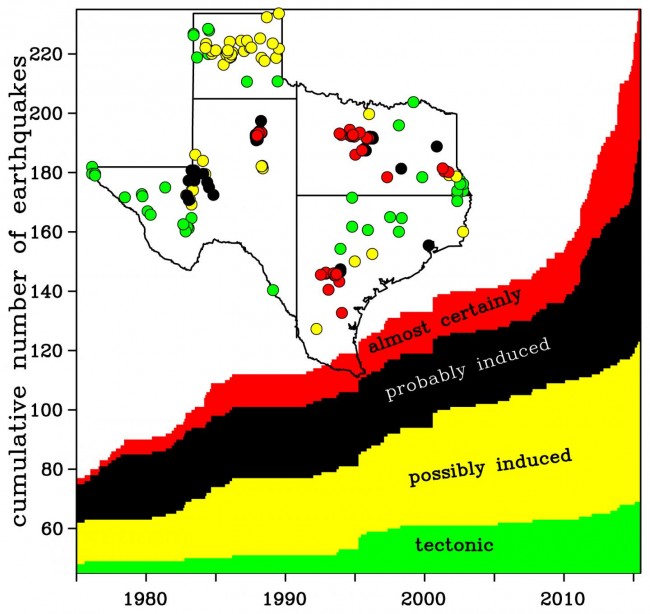Humans have been causing earthquakes in Texas since the 1920s
May 18, 2016

Earthquakes triggered by human activity have been happening in Texas since at least 1925, and they have been widespread throughout the state ever since, according to a new historical review of the evidence published online May 18 in Seismological Research Letters.
The earthquakes are caused by oil and gas operations, but the specific production techniques behind these quakes have differed over the decades, according to Cliff Frohlich, the study’s lead author and senior research scientist and associate director at the Institute for Geophysics at The University of Texas at Austin Jackson School of Geosciences.
Frohlich said the evidence presented in the SRL paper should lay to rest the idea that there is no substantial proof for human-caused earthquakes in Texas, as some state officials have claimed as recently as 2015.
At the same time, Frohlich said, the study doesn’t single out any one or two industry practices that could be managed or avoided to stop these kinds of earthquakes from occurring.
“I think we were all looking for what I call the silver bullet, supposing we can find out what kinds of practices were causing the induced earthquakes, to advise companies or regulators,” he said. “But that silver bullet isn’t here.”
The researchers write that since 2008, the rate of Texas earthquakes greater than magnitude 3 has increased from about two per year to 12 per year. This change appears to stem from an increase in earthquakes occurring within 1-3 kilometers of petroleum production wastewater disposal wells where water is injected at a high monthly rate, they note.
Some of these more recent earthquakes include the Dallas-Fort Worth International Airport sequence between 2008 and 2013; the May 2012 Timpson earthquake; and the earthquake sequence near Azle that began in 2013.
Frohlich and his colleagues suspected that induced seismicity might have a lengthy and geographically widespread history in Texas.
“But for me, the surprise was that oil field practices have changed so much over the years, and that probably affects the kinds of earthquakes that were happening at each time,” Frohlich said.
In the 1920s and 1930s, for instance, “they’d find an oilfield, and hundreds of wells would be drilled, and they’d suck oil out of the ground as fast as they could, and there would be slumps” that shook the earth as the volume of oil underground was rapidly extracted, he said.
When those fields were mostly depleted, in the 1940s through the 1970s, petroleum operations “started being more aggressive about trying to drive oil by water flooding” and the huge amounts of water pumped into the ground contributed to seismic activity, said Frohlich.
In the past decade, enhanced oil and gas recovery methods have produced considerable amounts of wastewater that is disposed by injection back into the ground through special wells, triggering nearby earthquakes. Most earthquakes linked to this type of wastewater disposal in Texas are smaller (less than magnitude 3) than those in Oklahoma, the study concludes.
The difference may lie in the types of oil operations in each state, Frohlich said. The northeast Texas injection earthquakes occur near high-injection rate wells that dispose of water produced in hydrofracturing operations, while much of the Oklahoma wastewater is produced during conventional oil production and injected deep into the underlying sedimentary rock.
For the moment, there have been no magnitude 3 or larger Texas earthquakes that can be linked directly to the specific process of hydrofracturing or fracking itself, such as have been felt in Canada, the scientists concluded.
Frohlich and colleagues used a five-question test to identify induced earthquakes in the Texas historical records. The questions cover how close in time and space earthquakes and petroleum operations are, whether the earthquake center is at a relatively shallow depth (indicating a human rather than natural trigger); whether there are known or suspected faults nearby that might support an earthquake or ease the way for fluid movement, and whether published scientific reports support a human cause for the earthquake.
In 2015, the Texas legislature funded a program that would install 22 additional seismic monitoring stations to add to the state’s existing 17 permanent stations, with the hopes of building out a statewide monitoring network that could provide more consistent and objective data on induced earthquakes.
– Release prepared by the journal Seismological Society of America.
